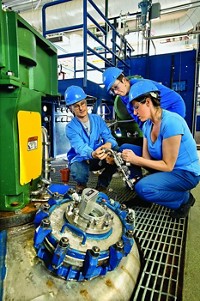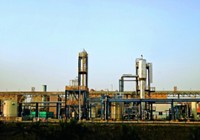Advertisement
Grab your lab coat. Let's get started
Welcome!
Welcome!
Create an account below to get 6 C&EN articles per month, receive newsletters and more - all free.
It seems this is your first time logging in online. Please enter the following information to continue.
As an ACS member you automatically get access to this site. All we need is few more details to create your reading experience.
Not you? Sign in with a different account.
Not you? Sign in with a different account.
ERROR 1
ERROR 1
ERROR 2
ERROR 2
ERROR 2
ERROR 2
ERROR 2
Password and Confirm password must match.
If you have an ACS member number, please enter it here so we can link this account to your membership. (optional)
ERROR 2
ACS values your privacy. By submitting your information, you are gaining access to C&EN and subscribing to our weekly newsletter. We use the information you provide to make your reading experience better, and we will never sell your data to third party members.
Business
Promising Plastic
Newlight Technologies’ young founders plan to make inexpensive material from waste gas
by Melody M. Bomgardner
January 14, 2013
| A version of this story appeared in
Volume 91, Issue 2

In October 2012, a cleantech start-up emerged from corporate stealth mode. Like many other start-ups, it claimed to have developed a microbe that will convert unwanted waste into valuable materials. But in contrast to most early-stage firms, Newlight Technologies also boasted a production facility and customers.
Newlight’s technology converts methane and carbon dioxide waste gases to polyhydroxyalkanoate plastics. The key to the transformation to PHA is enzymes produced by a modified microbe.
The inspiration for Newlight came from a newspaper article about cows, says Mark Herrema, the company’s chief executive officer. “That was in the summer of 2003 and it was about how much methane cows burp. It worked out to 500–600 L of methane per cow per day,” Herrema recalls. “It was a striking figure—there was so much opportunity there, and no one was touching it.”
At the time, Herrema was a political science major at Princeton University. He contacted his friend Kenton Kimmel, who was studying biomaterials and biotechnology at Northwestern University, and suggested that the two put together a biobased technology to take advantage of carbon-rich waste gas—albeit not from cow belches.
The two pursued the idea with zeal, even after graduation, although there were some twists and turns. They first looked at proteins, then decided to make plastics. After starting with methane, they worked to apply the technology to carbon dioxide. “We kept developing it,” Herrema recalls. “Our big mission was, ‘How do you make it cost-effective?’ ” They developed a homegrown microbe, he says, but kept their plans quiet until they could supply biobased plastics for less than the cost of similar materials made from petroleum.
Biobased plastics on the market today are made from sugar and are pricier than their hydrocarbon-based cousins. The Newlight bioreactor, in contrast, uses an input stream of 40% air and the rest carbon-containing waste gas. It is designed to use emissions from wastewater treatment systems, landfills, and energy facilities. And the process can use methane streams that are too dilute for energy production.
By 2007 the founders obtained the first patents for their microbe with a modified enzyme pathway. Newlight calls its modification process epigenetic engineering and claims that each unit of biocatalyst produces nine units of polymer by weight. The firm calls the high yield of the microbe the secret to its cost advantage.
Herrema and Kimmel kept their years-long development project mostly under wraps, but they quietly raised money in two phases. Then, in early October Newlight disclosed to the world that it was operating a facility in Southern California able to produce 50 tons of PHA per year. The inputs are methane from a wastewater treatment facility and natural gas. Currently, the output is being used in product development by two companies—a large office furniture maker and a major consumer products firm, which Newlight declines to name.
The two founders also developed technology to upgrade their PHA to substitute for petroleum-based polypropylene, polyethylene, and acrylonitrile-butadiene-styrene plastics. The resins work well on existing equipment and have the same performance characteristics as commodity plastics, Newlight says, although with a modified temperature profile.
The firm must be able to compete with conventional plastics if it is to survive in a young industry that is becoming crowded with PHA makers, says Kalib Kersh, an analyst at the consulting firm Lux Research who says he is intrigued by the new entrant. He points to two other start-ups, Oakbio and Micromidas, that want to make the biopolymer from waste. Oakbio has targeted CO2-rich flue gas from cement manufacturing, and Micromidas’ technology is based on organic wastewater.
Newlight is distinctive in that the founders are still at the top of the roster, Kersh observes. Herrema, as CEO, and Kimmel, as chief technology officer, have chosen to retain control of the company. Jim Stoppert, former CEO of bioplastics pioneer NatureWorks and a founder of five similar start-ups, was brought on a year ago to help with commercialization. Before accepting the job he took a close look at the technology with the help of a former colleague.
“These two guys never had experience working for companies before. When they first talked to me on the phone I couldn’t picture what this would look like,” recalls Stoppert, who is now Newlight’s head of business development. But he was won over. “They’ve done a very impressive job and been very methodical in their approach. They clearly had thought about most of the things you need to think about.”
Herrema has ambitious growth plans. He plans to raise an additional round of funding by the end of the first quarter and build a commercial-scale facility by the end of the year. The multi-million-pound-per-year plant, he claims, will be profitable. “We feel we have the most cost-effective way to produce plastics in the world,” Herrema says.






Join the conversation
Contact the reporter
Submit a Letter to the Editor for publication
Engage with us on Twitter